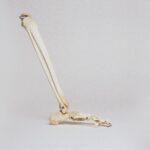 The new issue of our scientific journal Rare Diseases and Orphan Drugs is now online. The issue contains 9 publications on various topics. The editorial is “Do compulsory licenses have a place in the debate on access to innovative therapies?” If you would like to receive the latest information on rare diseases and orphan drugs, how the diagnostics and treatment is performed Bulgaria, please follow the link.
The new issue of our scientific journal Rare Diseases and Orphan Drugs is now online. The issue contains 9 publications on various topics. The editorial is “Do compulsory licenses have a place in the debate on access to innovative therapies?” If you would like to receive the latest information on rare diseases and orphan drugs, how the diagnostics and treatment is performed Bulgaria, please follow the link.
Publications
 Created under the 2011 Directive on Patient Rights’ in Cross-Border Healthcare, European Reference Networks (ERNs) are cross-border networks bringing together centres of expertise and reference centres of European hospitals to tackle rare or low prevalence and complex diseases and conditions that require highly specialised healthcare. ERNs enable specialists in Europe to share learnings and discuss complex patient cases, providing advice on the most appropriate diagnosis and the best treatment. A key principle of ERNs is to let the knowledge travel rather than the patient leading to economies of scale and more efficient use of costly resources. 24 ERNs covering all major rare disease groups were launched in March 2017, including 956 highly specialised healthcare units from 313 hospitals located in 26 countries (25 EU Member States plus Norway). Each Network has a Coordinator and the 24 of them are gathered within the ERN Coordinators group (ERN-CG) establishing a common ground on several key technical and organisational aspects of the Networks activities. The Board of Member States (BoMS), as laid out in the European Commission Implementing Decision was set up on 5 February 2014, and consist of the EU Member states and Norway. One of the tasks of the BoMS include the approval of healthcare providers wishing to join existing Networks. For more information and how to apply click here.
Created under the 2011 Directive on Patient Rights’ in Cross-Border Healthcare, European Reference Networks (ERNs) are cross-border networks bringing together centres of expertise and reference centres of European hospitals to tackle rare or low prevalence and complex diseases and conditions that require highly specialised healthcare. ERNs enable specialists in Europe to share learnings and discuss complex patient cases, providing advice on the most appropriate diagnosis and the best treatment. A key principle of ERNs is to let the knowledge travel rather than the patient leading to economies of scale and more efficient use of costly resources. 24 ERNs covering all major rare disease groups were launched in March 2017, including 956 highly specialised healthcare units from 313 hospitals located in 26 countries (25 EU Member States plus Norway). Each Network has a Coordinator and the 24 of them are gathered within the ERN Coordinators group (ERN-CG) establishing a common ground on several key technical and organisational aspects of the Networks activities. The Board of Member States (BoMS), as laid out in the European Commission Implementing Decision was set up on 5 February 2014, and consist of the EU Member states and Norway. One of the tasks of the BoMS include the approval of healthcare providers wishing to join existing Networks. For more information and how to apply click here.
 Limb-girdle muscular dystrophy (LGMD) consists of over 30 genetic conditions with varying clinical phenotypes primarily affecting pelvic girdle, shoulder girdle, and other proximal limb muscles. Studies focusing on the physical, mental, and social effects of this disease from the patient’s perspective are limited. Adults with LGMD were interviewed and asked to identify issues that have the greatest impact on their quality of life. Each interview was recorded, transcribed, coded, and analyzed. Participants provided 1385 direct quotes. One hundred sixty-five potential symptoms of importance were identified and grouped into 15 larger themes. The most frequently reported themes included limitations with mobility, difficulty performing activities, social role limitations, and emotional distress. There are multiple symptoms that alter the lives of adults with LGMD. These affect their physical, emotional, and social health, and may be amenable to medical intervention. For more information click here.
Limb-girdle muscular dystrophy (LGMD) consists of over 30 genetic conditions with varying clinical phenotypes primarily affecting pelvic girdle, shoulder girdle, and other proximal limb muscles. Studies focusing on the physical, mental, and social effects of this disease from the patient’s perspective are limited. Adults with LGMD were interviewed and asked to identify issues that have the greatest impact on their quality of life. Each interview was recorded, transcribed, coded, and analyzed. Participants provided 1385 direct quotes. One hundred sixty-five potential symptoms of importance were identified and grouped into 15 larger themes. The most frequently reported themes included limitations with mobility, difficulty performing activities, social role limitations, and emotional distress. There are multiple symptoms that alter the lives of adults with LGMD. These affect their physical, emotional, and social health, and may be amenable to medical intervention. For more information click here.
 Fibrodysplasia ossificans progressiva (FOP) is an extremely rare and severely disabling autosomal dominant disease that is yet to be clearly understood. The purpose of this review is to present recent literature on pathophysiology, clinical features, diagnosis and treatment of FOP. FOP is characterized by congenital great toe deformity and progressive heterotopic ossifications in connective tissue. Heterotopic ossifications occur after painful flare-ups that can arise spontaneously or can be triggered by minor trauma. Each flare-up ultimately causes restriction of related-joint, and along with the others eventually leads to immobility. Death is usually caused by pulmonary complications because of chest wall involvement. The causative gene of FOP is activin A receptor type 1 (ACVR1), a bone morphogenetic protein-signalling component, which normally acts to inhibit osteoblastogenesis. The treatment of FOP is still preventive and supportive. Although there are still gaps in the underlying mechanism of FOP, effective treatment options, such as potential pharmacologic targets and cell-based therapies are promising for the future. Some of these were tested without a clinical trial setting, and are currently in the process of evidence-based research. For more information click here.
Fibrodysplasia ossificans progressiva (FOP) is an extremely rare and severely disabling autosomal dominant disease that is yet to be clearly understood. The purpose of this review is to present recent literature on pathophysiology, clinical features, diagnosis and treatment of FOP. FOP is characterized by congenital great toe deformity and progressive heterotopic ossifications in connective tissue. Heterotopic ossifications occur after painful flare-ups that can arise spontaneously or can be triggered by minor trauma. Each flare-up ultimately causes restriction of related-joint, and along with the others eventually leads to immobility. Death is usually caused by pulmonary complications because of chest wall involvement. The causative gene of FOP is activin A receptor type 1 (ACVR1), a bone morphogenetic protein-signalling component, which normally acts to inhibit osteoblastogenesis. The treatment of FOP is still preventive and supportive. Although there are still gaps in the underlying mechanism of FOP, effective treatment options, such as potential pharmacologic targets and cell-based therapies are promising for the future. Some of these were tested without a clinical trial setting, and are currently in the process of evidence-based research. For more information click here.
 Systemic mastocytosis (SM) is a rare disease which is characterized by the accumulation of mast cells in >1 extra-cutaneous organ, most often the bone marrow. In the majority of patients, the activating D816V mutation in KIT induces increased proliferation and survival in the neoplastic mast cells. The WHO has formulated criteria for the diagnosis of SM: Most criteria can usually only be obtained by bone marrow (BM) aspiration and biopsy. Due to the heterogeneous clinical picture of SM, it can be challenging to determine when BM examination is indicated. Serum tryptase is often used as a screening tool for SM. For more information click here.
Systemic mastocytosis (SM) is a rare disease which is characterized by the accumulation of mast cells in >1 extra-cutaneous organ, most often the bone marrow. In the majority of patients, the activating D816V mutation in KIT induces increased proliferation and survival in the neoplastic mast cells. The WHO has formulated criteria for the diagnosis of SM: Most criteria can usually only be obtained by bone marrow (BM) aspiration and biopsy. Due to the heterogeneous clinical picture of SM, it can be challenging to determine when BM examination is indicated. Serum tryptase is often used as a screening tool for SM. For more information click here.
 Castleman’s disease is a rare disease of the lymph nodes and related tissues, presenting as angiofollicular or giant lymph node hyperplasia. Although various skin manifestations have been reported to occur in Castleman’s disease, a comprehensive study of cutaneous disorders in Castleman’s disease is lacking. Therefore, the aim of this study was to investigate Castleman’s disease-associated cutaneous disorders. The medical records of 57 patients with Castleman’s disease who visited our hospitals from January 2007 to May 2018 were analysed retrospectively. Patients were classified according to the presence of skin involvement. Plasma variant-type Castleman’s disease and multicentric Castleman’s disease were more commonly found in patients with Castleman’s disease with a cutaneous disorder than in those without a cutaneous disorder. In addition, the skin disorders were classified according to pathomechanisms: immune complex-related (paraneoplastic pemphigus, xanthogranulomas), cytokine-related (vasculitis-like lesion, cherry angioma, hyperpigmentation), and non-specific (pruritus). This study builds on previous case reports of cutaneous disorders in Castleman’s disease and proposes a new classification system. For more information click here.
Castleman’s disease is a rare disease of the lymph nodes and related tissues, presenting as angiofollicular or giant lymph node hyperplasia. Although various skin manifestations have been reported to occur in Castleman’s disease, a comprehensive study of cutaneous disorders in Castleman’s disease is lacking. Therefore, the aim of this study was to investigate Castleman’s disease-associated cutaneous disorders. The medical records of 57 patients with Castleman’s disease who visited our hospitals from January 2007 to May 2018 were analysed retrospectively. Patients were classified according to the presence of skin involvement. Plasma variant-type Castleman’s disease and multicentric Castleman’s disease were more commonly found in patients with Castleman’s disease with a cutaneous disorder than in those without a cutaneous disorder. In addition, the skin disorders were classified according to pathomechanisms: immune complex-related (paraneoplastic pemphigus, xanthogranulomas), cytokine-related (vasculitis-like lesion, cherry angioma, hyperpigmentation), and non-specific (pruritus). This study builds on previous case reports of cutaneous disorders in Castleman’s disease and proposes a new classification system. For more information click here.
 The objectives аre to evaluate the efficacy and safety of apremilast in treating oral ulcers (OUs), the cardinal and high-disabling feature of Behçet’s disease (BD). Twelve consecutive patients affected by BD with recurrent/relapsing OUs resistant and/or intolerant to conventional therapy were enrolled and prospectively followed. The primary endpoint was the number of OUs at week 12. Secondary endpoints were modification from baseline to week 12 in Behçet’s Syndrome Activity Score (BSAS), Behçet’s Disease Current Activity Form (BDCAF) score, Behçet’s Disease Quality of Life (BDQOL) scale and pain of OUs, as measured by a visual analogue scale (VAS). All adverse events (AEs) were recorded during follow-up. Non-parametric tests (Wilcoxon rank test) were used and a P-value <0.05 was considered statistically significant. Our preliminary real-world data support the use of apremilast as an effective therapeutic strategy against BD-related recurrent OUs resistant or intolerant to first-line therapy. For more information click here.
The objectives аre to evaluate the efficacy and safety of apremilast in treating oral ulcers (OUs), the cardinal and high-disabling feature of Behçet’s disease (BD). Twelve consecutive patients affected by BD with recurrent/relapsing OUs resistant and/or intolerant to conventional therapy were enrolled and prospectively followed. The primary endpoint was the number of OUs at week 12. Secondary endpoints were modification from baseline to week 12 in Behçet’s Syndrome Activity Score (BSAS), Behçet’s Disease Current Activity Form (BDCAF) score, Behçet’s Disease Quality of Life (BDQOL) scale and pain of OUs, as measured by a visual analogue scale (VAS). All adverse events (AEs) were recorded during follow-up. Non-parametric tests (Wilcoxon rank test) were used and a P-value <0.05 was considered statistically significant. Our preliminary real-world data support the use of apremilast as an effective therapeutic strategy against BD-related recurrent OUs resistant or intolerant to first-line therapy. For more information click here.
 Primary spontaneous pneumothorax (PSP) is not an uncommon disease, especially in patients with risk factors such as male gender, history of smoking, and low body mass index (BMI). Amyotrophic lateral sclerosis (ALS) is a rare disease caused by neurodegeneration of the motor neurons that share risk factors with PSP. The aim of this study was to determine the prevalence of PSP in ALS and find the significant risk factors related to PSP. We retrospectively reviewed the data from 86 patients with clinically probable or definite ALS from three different centers. Clinical characteristics, including age, sex, subtype, disease duration, body mass index, history of smoking, tracheostomy state, and ventilator use, were obtained. The ALS Functional Rating Scale-Revised Form (ALSFRS-R) total score and subscores were also retrieved from the medical records. In the results, six of the 86 patients (7%) had PSP. There were no statistically significant differences among the clinical characteristics and the ALSFRS-R scores between the patients with and without PSP, except for BMI and smoking (p < 0.022 and p < 0.019, respectively). A multivariate logistic regression analysis of smoking and BMI showed an odds ratio of 19.25. In conclusion, the existence of PSP in ALS may be under-recognized. Further well-designed, large studies are needed to elucidate the prevalence and pathophysiology of pneumothorax in ALS. For more information click here.
Primary spontaneous pneumothorax (PSP) is not an uncommon disease, especially in patients with risk factors such as male gender, history of smoking, and low body mass index (BMI). Amyotrophic lateral sclerosis (ALS) is a rare disease caused by neurodegeneration of the motor neurons that share risk factors with PSP. The aim of this study was to determine the prevalence of PSP in ALS and find the significant risk factors related to PSP. We retrospectively reviewed the data from 86 patients with clinically probable or definite ALS from three different centers. Clinical characteristics, including age, sex, subtype, disease duration, body mass index, history of smoking, tracheostomy state, and ventilator use, were obtained. The ALS Functional Rating Scale-Revised Form (ALSFRS-R) total score and subscores were also retrieved from the medical records. In the results, six of the 86 patients (7%) had PSP. There were no statistically significant differences among the clinical characteristics and the ALSFRS-R scores between the patients with and without PSP, except for BMI and smoking (p < 0.022 and p < 0.019, respectively). A multivariate logistic regression analysis of smoking and BMI showed an odds ratio of 19.25. In conclusion, the existence of PSP in ALS may be under-recognized. Further well-designed, large studies are needed to elucidate the prevalence and pathophysiology of pneumothorax in ALS. For more information click here.
 Multiple Endocrine Neoplasia type 1 (MEN1) has been causing problems for clinicians since it was described in 1954 by Wermer. Not only its rarity, but also variable clinical manifestations and no genotype-phenotype correlation make it hard to establish evidence-based guidelines for management of this syndrome. Nationwide registers and population-based researches are the best means to improve knowledge about this rare disease. By now, there was no example of such research in the Polish population of MEN1 patients. We performed a retrospective analysis of clinical and genetic data of patients diagnosed with MEN1 syndrome and followed-up in two polish referral centers in years 1994-2018. Polish population of patients with MEN1 is different than previously described European and Asian populations primarily in prevalence of functional NETs. Frameshift mutation with STOP codon of MEN1 gene increase significantly risk of PA. Further studies, with a larger cohort of patients, are needed to fully describe the Polish population and improve diagnosis and management of the syndrome. For more information click here.
Multiple Endocrine Neoplasia type 1 (MEN1) has been causing problems for clinicians since it was described in 1954 by Wermer. Not only its rarity, but also variable clinical manifestations and no genotype-phenotype correlation make it hard to establish evidence-based guidelines for management of this syndrome. Nationwide registers and population-based researches are the best means to improve knowledge about this rare disease. By now, there was no example of such research in the Polish population of MEN1 patients. We performed a retrospective analysis of clinical and genetic data of patients diagnosed with MEN1 syndrome and followed-up in two polish referral centers in years 1994-2018. Polish population of patients with MEN1 is different than previously described European and Asian populations primarily in prevalence of functional NETs. Frameshift mutation with STOP codon of MEN1 gene increase significantly risk of PA. Further studies, with a larger cohort of patients, are needed to fully describe the Polish population and improve diagnosis and management of the syndrome. For more information click here.
 The increased survival of urea cycle disorders (UCDs) patients has led the attention to clinical manifestations that characterize the long-term disease course. Acute and chronic liver disease have been anecdotally reported since the very first description of UCDs. However a detailed analysis of long-term liver involvement in large patient cohorts is still needed. Chronic liver damage in UCDs has probably a multifactorial origin, but the specific underlying mechanisms of liver disease have not yet been well elucidated. In this study, we report on chronic liver involvement and on associated metabolic abnormalities in a large cohort of 102 UCD patients, followed by two reference centers in Italy. Chronic liver involvement was observed in over 60% of UCDs patients, and comparison between individual diseases showed a significant higher frequency in ASLD and in HHH syndrome with elevation of transaminases and of gamma-GT in ASLD, and of alpha-fetoprotein in HHH syndrome. Also, consistent with a chronic hepatic dysfunction, ultrasound examination revealed more pronounced abnormalities in ASLD and in HHH syndrome, when compared to other UCDs. Our study highlights in a large UCDs patients’ cohort that chronic liver disease is a common finding in UCDs, often with a distinct phenotype between different diseases. Furthers studies are needed to elucidate the specific involvement of different metabolic pathways in the pathogenesis of liver dysfunction in UCDs. For more information click here.
The increased survival of urea cycle disorders (UCDs) patients has led the attention to clinical manifestations that characterize the long-term disease course. Acute and chronic liver disease have been anecdotally reported since the very first description of UCDs. However a detailed analysis of long-term liver involvement in large patient cohorts is still needed. Chronic liver damage in UCDs has probably a multifactorial origin, but the specific underlying mechanisms of liver disease have not yet been well elucidated. In this study, we report on chronic liver involvement and on associated metabolic abnormalities in a large cohort of 102 UCD patients, followed by two reference centers in Italy. Chronic liver involvement was observed in over 60% of UCDs patients, and comparison between individual diseases showed a significant higher frequency in ASLD and in HHH syndrome with elevation of transaminases and of gamma-GT in ASLD, and of alpha-fetoprotein in HHH syndrome. Also, consistent with a chronic hepatic dysfunction, ultrasound examination revealed more pronounced abnormalities in ASLD and in HHH syndrome, when compared to other UCDs. Our study highlights in a large UCDs patients’ cohort that chronic liver disease is a common finding in UCDs, often with a distinct phenotype between different diseases. Furthers studies are needed to elucidate the specific involvement of different metabolic pathways in the pathogenesis of liver dysfunction in UCDs. For more information click here.
